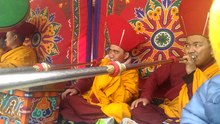Dung

Dungchen ( Tibetan དུང་ ཆེན །, Wylie : dung chen ) is a brass instrument made of copper or a copper alloy that is played in Tibetan music and is one of the natural trumpets commonly known in Tibet as dung (“shell”) . The alternative name dun dmar is translated as "red trumpet" and refers to the material used.
Design and style of play
The dungchen is similar to the alphorn and produces a deep and voluminous tone. It is often used at Tibetan Buddhist ceremonies outdoors or in the assembly hall in ensembles of at least two or more players. The instruments are tuned to the same pitch. Is blown Dungchen with a tuba -like instrument mouthpiece . Like any brass instrument has the Dungchen log from the mouthpiece to the sound opening conically widening tube. The length varies from approx. 0.9 to 4.5 meters. Large dunglets are made from three parts that can be telescoped into one another for transport.
Three tones from the series of natural tones are produced, each one octave apart . The tones are marked with dor for the lowest, gyang for the middle and ti for the highest tone. In the dor , the lower lip covers the inner opening of the mouthpiece and moves back and forth while the upper lip touches the mouthpiece at the top. In gyang the lips are pressed together; even more so with the ti , where the lips are fully pressed into the mouthpiece. Absolute harmony between the two instruments is neither achieved nor is this considered desirable. Nor is it about defined pitches or harmonies.
A shorter version, around 1.2 meters long, is dsog-dung , which is only played in the assembly halls. In the orchestra the dungchen sounded together with the snail horn dung-kar , the stem bell drilbu , the small hourglass drum with clappers damaru , the shorter metal trumpet tsog-kang with "crocodile mouth ", the vertically held pair basin silnyèn and the horizontally held pair basin rol-mo ( rölmo ).
Because of its long length, the dungchen must be blown with great pressure, which is why young students can only practice on the shorter metal trumpet rkang gling ( kang-ling ) or the snail horn and are only allowed to play dungchen from around the age of 13 . Then they got to know the way of playing by observing them daily while making music and at events.
In the monasteries of the Karma Kagyu tradition, the tones are notated with the help of cloud-like curved lines. Each curve stands for a change into a different overtone, the strength of the lines indicates the volume. In contrast, in the Nechung monastery , which is part of the Gelug tradition , the notes are notated using a sequence of vertical lines. The three tones are represented with a circle, a vertical straight line and a line with a tick at the top. A <-shaped bulge on the vertical line indicates an asymmetrical change in dynamics. The sound gradually gets louder and then suddenly breaks off again to the quiet starting sound.
distribution
In Ladakh the long trumpet is called tunchen. Long straight natural trumpets are used in some regions of India in Hindu worship rituals ( puja ) at temples or in other ceremonial music. In terms of form and religious function, the following are related to the dungchen : the pongal or karnal of the Newar in Nepal, the bhankora in the Indian region of Garhwal on the southern edge of the Himalayas, the two-part bhungal and the same karna in Rajasthan ( karnat in Gujarat ) as well as the tirucinnam , ekkalam and gowri kalam in Tamil Nadu . The neku used by the Newar in Nepal in Buddhist processions consists of a curved, funnel-shaped buffalo horn that is lengthened with a bamboo tube.
literature
- Brian Pertl: Some Observations of the Dung Chen of the Nechung Monastery. In: Asian Music, Vol. 23, No. 2, Spring / Summer 1992, pp. 89-96
- Eben Yonnetti: Like the Roar of a Thousand Thunders: Instrumental Music and Creativity in Tibetan Buddhist Ritual. In: Independent Study Project (ISP) Collection, SIT Study Abroad, Spring 2011, pp. 23f
Web links
- Film about the production of dungchen (Tibetan longhorn) in Nepal
- Dungchen The powerful magic of LOW sounds. Scientific research. Youtube video
Individual evidence
- ^ Daniel A. Scheidegger: Tibetan Ritual Music. A General Survey with Special Reference to the Mindroling Tradition. ( Opuscula Tibetana . Work from the Tibet Institute) Rikon-Zurich 1988, pp. 22, 90, 92
- ^ Brian Pertl, pp. 90-92
- ↑ See Paul D. Greene: Sounding the Body in Buddhist Nepal: Neku Horns, Himalayan Shamanism, and the Transmigration of the Disembodied Spirit. In: The World of Music, Volume 44, No. 2 ( Body and Ritual in Buddhist Musical Cultures ) 2002, pp. 93-114

